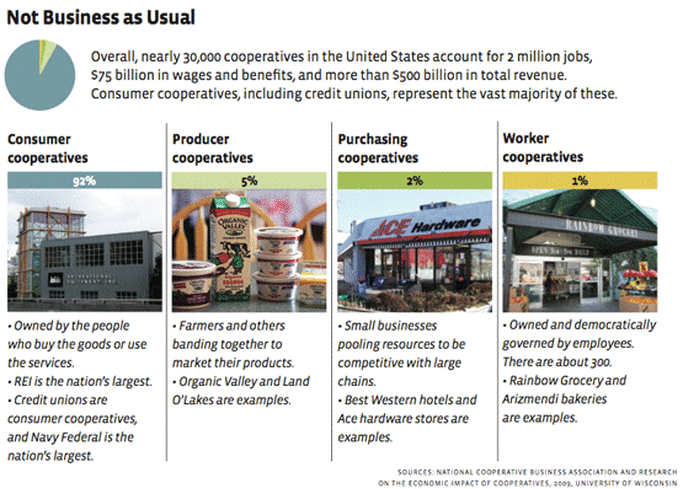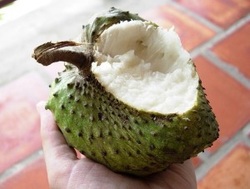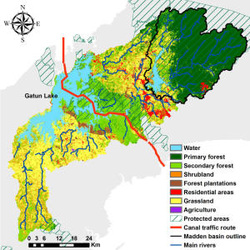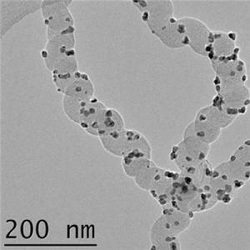
Pushing my grocery cart down the aisle, I spot on the fruit counter a dozen plastic bags of bananas labeled “Organic, Equal Exchange.” My heart leaps a little. I’d been thrilled, months earlier, when I found my local grocer carrying bananas—a new product from Equal Exchange—because this employee-owned cooperativeme outside Boston is one of my favorite companies. Its main business remains the fair trade coffee and chocolate the company started with in 1986. Since then, the company has flourished, and its mission remains supporting small farmer co-ops in developing countries and giving power to employees through ownership. It’s as close to an ideal company as I’ve found. And I’m delighted to see their banana business thriving, since I know it was rocky for a time. (Hence the leaping of my heart.)
I happen to know a bit more than the average shopper about Equal Exchange, because I count myself lucky to be one of its few investors who are not worker-owners. Over more than 20 years, it has paid investors a steady and impressive average of 5 percent annually (these days, a coveted return).
Maneuvering my cart toward the dairy case, I search out butter made by Cabot Creamery, and pick up some Cabot cheddar cheese. I choose Cabot because, like Equal Exchange, it’s a cooperative, owned by dairy farmers since 1919.
At the checkout, I hand over my Visa card from Summit Credit Union, a depositor-owned bank in Madison, Wis., where I lived years ago. Credit unions are another type of cooperative, meaning that members like me are partial owners, so Summit doesn’t charge us the usurious penalty rate of 25 percent or more levied by other banks at the merest breath of a late payment. They’re loyal to me, and I’m loyal to them.
On my way home, I pull up to the drive-through at Beverly Cooperative Bank to make a withdrawal. This bank is yet another kind of cooperative—owned by customers and designed to serve them. Though it’s small—with only $700 million in assets, and just four branches (all of which I could reach on my bike)—its ATM card is recognized everywhere. I’ve used it even in Copenhagen and London.
With this series of transactions on one afternoon, I am weaving my way through a profoundly different and virtually invisible world: the cooperative economy. It’s an economy that aims to serve customers, rather than extract maximum profits from them. It operates through various models, which share the goal of treating suppliers, employees, and investors fairly. The cooperative economy has dwelled alongside the corporate economy for close to two centuries. But it may be an economy whose time has come.
Something is dying in our time. As the nation struggles to recover from unsustainable personal and national debt, stagnant wages, the damages wrought by climate change, and more, a whole way of life is drawing to a close. It began with railroads and steam engines at the dawn of the Industrial Age, and over two centuries has swelled into a corporation-dominated system marked today by vast wealth inequity and bloated carbon emissions. That economy is today proving fundamentally unsustainable. We’re hitting twin limits, ecological and financial. We’re experiencing both ecological and financial overshoot.
If ecological limits are something many of us understand, we’re just beginning to find language to talk about financial limits—that point of diminishing return where the hunt for financial gain actually depletes the tax-and-wage base that sustains us all.
Here’s the problem: The very aim of maximum financial extraction is built into the foundational social architecture of our capitalist economy—that is, the concept of ownership.
If the root of government is sovereignty (the question of who controls the state), the root construct of every economy is property (the question of who controls the infrastructure of wealth creation).
Many of the great social struggles in history have come down to the issue of who will control land, water, and the essentials of life. Ownership has been at the center of the most profound changes in civilization—from ending slavery to patenting the genome of life.
Throughout the Industrial Age, the global economy has increasingly come to be dominated by a single form of ownership: the publicly traded corporation, where shares are bought and sold in stock markets. The systemic crises we face today are deeply entwined with this design, which forms the foundation of what we might call the extractive economy, intent on maximum physical and financial extraction.
The concept of extractive ownership traces its lineage to Anglo-Saxon legal tradition. The 18th century British legal theorist William Blackstone described ownership as the right to “sole and despotic dominion.” This view—the right to control one’s world in order to extract maximum benefit for oneself—is a core legitimating concept for a civilization in which white, property-owning males have claimed dominion over women, other races, laborers, and the earth itself.
In the 20th century, we were schooled to believe there were essentially two economic systems: capitalism (private ownership) and socialism/communism (public ownership). Yet both tended, in practice, to support the concentration of economic power in the hands of the few.
Emerging in our time—in largely disconnected experiments across the globe—are the seeds of a different kind of economy. It, too, is built on a foundation of ownership, but of a unique type. The cooperative economy is a large piece of it. But this economy doesn’t rely on a monoculture of design, the way capitalism does. It’s as rich in diversity as a rainforest is in its plethora of species—with commons ownership, municipal ownership, employee ownership, and others. You could even include open-source models like Wikipedia, owned by no one and managed collectively.
These varieties of alternative ownership have yet to be recognized as a single family, in part because they’ve yet to unite under a common name. We might call them generative, for their aim is to generate conditions where our common life can flourish. Generative design isn’t about dominion. It’s about belonging—a sense of belonging to a common whole.
We see this sensibility in a variety of alternatives gaining ground today. New state laws chartering benefit corporations have passed recently in 12 states, and are in the works in 14 more. Benefit corporations—like Patagonia and Seventh Generation—build into their governing documents a commitment to serve not only stockholders but other stakeholders, including employees, the community, and the environment.
Also spreading are social enterprises, which serve a social mission while still functioning as businesses (many of them owned by nonprofits). Employee-owned firms are gaining ground in Spain, Poland, France, Denmark, and Sweden. Still another model is the mission-controlled corporation, exemplified by foundation-owned companies such as Novo Nordisk and Ikea in northern Europe. While publicly traded, these companies safeguard their social purpose by keeping board control in mission-oriented hands.
If there are more kinds of generative ownership than most of us realize, the scale of activity is also larger than we might suppose—particularly in the cooperative economy. In the United States, more than 130 million people are members of a co-op or credit union. More Americans hold membership in a co-op than hold shares in the stock market. Worldwide, cooperatives have close to a billion members. Among the 300 largest cooperative and mutually owned companies worldwide, total revenues approach $2 trillion. If these enterprises were a single nation, its economy would be the 9th largest on earth.
Often, these entities are profit making, but they’re not profit maximizing. Alongside more traditional nonprofit and government models, they add a category of private ownership for the common good. Their growth across the globe represents a largely unheralded revolution.
What unites generative designs are the living purposes at their core, and the beneficial outcomes they tend to generate. More research remains to be done, but there is evidence that these models create broad benefits and remain resilient in crisis. We’ve seen this, for example, in the success of the state-owned Bank of North Dakota, which remained strong in the 2008 crisis, even as other banks foundered; this led more than a dozen states to pursue similar models. We’ve seen it in the behavior of credit unions, which tended not to create toxic mortgages, and required few bailouts.
We’ve seen it in the fact that workers at firms with employee stock ownership plans enjoy more than double the defined-benefit retirement assets of comparable employees at other firms. And we’ve seen it in the fact that the Basque region of Spain—home to the massive Mondragon cooperative—has seen substantially lower unemployment than the country as a whole.
Together, these various models might one day form the foundation for a generative economy, where the intent is to meet human needs and create conditions in which life can thrive. Generative ownership aims to do what the butcher, the baker, and the candlestick maker have always done: make a living by serving the community. The profit-maximizing corporation is the real detour in the evolution of ownership, and it’s a relatively recent detour at that.
The resilience of generative design is a key reason that people have often turned to these models in times of crisis. When the Industrial Revolution was forcing many skilled workers into poverty in the 1840s, weavers and artisans banded together to form the Rochdale Society of Equitable Pioneers, the first modern, consumer-owned cooperative, selling food to members who couldn’t otherwise afford it.
During the Great Depression in the United States, the Federal Credit Union Act—ensuring that credit would be available to people of meager means—was intended to help stabilize an imbalanced financial system. Today, credit union assets total more than $700 billion. In the recent financial crisis, their loan delinquency rates were half those of traditional banks. Since the crisis, credit unions have added more than 1.5 million members. In Argentina in 2001, when a financial meltdown created thousands of bankruptcies and saw many business owners flee, workers—with government support—took over more than 200 firms and ran these empresas recuperadas themselves, and they’re still running them.
Last year, with financial and ecological crises mounting worldwide, the U.N. named 2012 the Year of the Cooperative, and cooperative activity, is advancing around the globe. Cooperatives were largely sidelined during the rise of the industrial age. But current trends indicate that conditions may be ripe for a surge in cooperative enterprises. As people lose faith in the stock market, feel mounting anger at banks, and distrust high-earning CEOs, there’s growing distaste for the business-as-usual Wall Street model. Meanwhile, the Internet has enabled the expansion of informal cooperation on an unprecedented scale—with the Creative Commons, for example, now encompassing more than 450,000 works. As the speculative, mass-production economy hits limits, cooperatives may be uniquely suited to a post-growth world, for they are active in sectors related to fundamental needs (agriculture, insurance, food, finance, and electricity comprise the top five co-op sectors).
If many of us fail to recognize an emerging ownership shift as a sign of progress, it may be because it arises from an unexpected place—not from government action, or protests in the streets, but from within the structure of our economy itself. Not from the leadership of a charismatic individual, but from the longing in many hearts, the genius of many minds, the effort of many hands to build what we know, instinctively, that we need.
This goes much deeper than legal or financial engineering. It’s about a shift in the cultural values that underpin social institutions. History has seen such shifts before—in the values that underlay the monarchy, racism, and sexism. What’s weakening today is a different kind of systemic bias. It’s capital bias: capital-ism—the belief system that maximizing capital matters more than anything else.
The cooperative economy—and the broader family of generative ownership models—is helping to reawaken an ancient wisdom about living together in community, something largely lost in the spread of capitalism. Economic historian Karl Polanyi describes this in his 1944 work, The Great Transformation, tracing the crises of capitalism to the fact that it “disembedded” economic activity from community. Throughout history, he noted, economic activity had been part of a larger social order that included religion, government, families, and the natural world. The Industrial Revolution upended this. It turned labor and land into commodities to be “bought and sold, used and destroyed, as if they were simply merchandise,” Polanyi wrote. But these were fictitious commodities. They were none other than human beings and the earth itself.
Generative design decommodifies land and labor, putting them again under the control of the community.
It’s no accident that the deep redesign of our economy isn’t beginning in Washington, D.C. It is rooted in relationships: to the living earth and to one another. The generative economy finds fertile soil for its growth within the human heart. The ownership revolution is part of the “metaphysical reconstruction” that E.F. Schumacher said would be needed to transform our economy. When economic relations are designed in a generative way, they’re no longer about sole and despotic dominion. Economic activity is no longer about squeezing every penny from something we imagine that we own. It’s about being interwoven with the world around us. It’s about a shift from dominion to community.
Marjorie Kelly wrote this article for How Cooperatives Are Driving the New Economy, the Spring 2013 issue of YES! Magazine. Marjorie is a fellow with the Tellus Institute and is director of ownership strategy with Cutting Edge Capital consulting firm. She is author of the new book, Owning Our Future: The Emerging Ownership Revolution. She was co-founder and for 20 years president of Ethics magazine.
Interested?
Image Credit and Source
I happen to know a bit more than the average shopper about Equal Exchange, because I count myself lucky to be one of its few investors who are not worker-owners. Over more than 20 years, it has paid investors a steady and impressive average of 5 percent annually (these days, a coveted return).
Maneuvering my cart toward the dairy case, I search out butter made by Cabot Creamery, and pick up some Cabot cheddar cheese. I choose Cabot because, like Equal Exchange, it’s a cooperative, owned by dairy farmers since 1919.
At the checkout, I hand over my Visa card from Summit Credit Union, a depositor-owned bank in Madison, Wis., where I lived years ago. Credit unions are another type of cooperative, meaning that members like me are partial owners, so Summit doesn’t charge us the usurious penalty rate of 25 percent or more levied by other banks at the merest breath of a late payment. They’re loyal to me, and I’m loyal to them.
On my way home, I pull up to the drive-through at Beverly Cooperative Bank to make a withdrawal. This bank is yet another kind of cooperative—owned by customers and designed to serve them. Though it’s small—with only $700 million in assets, and just four branches (all of which I could reach on my bike)—its ATM card is recognized everywhere. I’ve used it even in Copenhagen and London.
With this series of transactions on one afternoon, I am weaving my way through a profoundly different and virtually invisible world: the cooperative economy. It’s an economy that aims to serve customers, rather than extract maximum profits from them. It operates through various models, which share the goal of treating suppliers, employees, and investors fairly. The cooperative economy has dwelled alongside the corporate economy for close to two centuries. But it may be an economy whose time has come.
Something is dying in our time. As the nation struggles to recover from unsustainable personal and national debt, stagnant wages, the damages wrought by climate change, and more, a whole way of life is drawing to a close. It began with railroads and steam engines at the dawn of the Industrial Age, and over two centuries has swelled into a corporation-dominated system marked today by vast wealth inequity and bloated carbon emissions. That economy is today proving fundamentally unsustainable. We’re hitting twin limits, ecological and financial. We’re experiencing both ecological and financial overshoot.
If ecological limits are something many of us understand, we’re just beginning to find language to talk about financial limits—that point of diminishing return where the hunt for financial gain actually depletes the tax-and-wage base that sustains us all.
Here’s the problem: The very aim of maximum financial extraction is built into the foundational social architecture of our capitalist economy—that is, the concept of ownership.
If the root of government is sovereignty (the question of who controls the state), the root construct of every economy is property (the question of who controls the infrastructure of wealth creation).
Many of the great social struggles in history have come down to the issue of who will control land, water, and the essentials of life. Ownership has been at the center of the most profound changes in civilization—from ending slavery to patenting the genome of life.
Throughout the Industrial Age, the global economy has increasingly come to be dominated by a single form of ownership: the publicly traded corporation, where shares are bought and sold in stock markets. The systemic crises we face today are deeply entwined with this design, which forms the foundation of what we might call the extractive economy, intent on maximum physical and financial extraction.
The concept of extractive ownership traces its lineage to Anglo-Saxon legal tradition. The 18th century British legal theorist William Blackstone described ownership as the right to “sole and despotic dominion.” This view—the right to control one’s world in order to extract maximum benefit for oneself—is a core legitimating concept for a civilization in which white, property-owning males have claimed dominion over women, other races, laborers, and the earth itself.
In the 20th century, we were schooled to believe there were essentially two economic systems: capitalism (private ownership) and socialism/communism (public ownership). Yet both tended, in practice, to support the concentration of economic power in the hands of the few.
Emerging in our time—in largely disconnected experiments across the globe—are the seeds of a different kind of economy. It, too, is built on a foundation of ownership, but of a unique type. The cooperative economy is a large piece of it. But this economy doesn’t rely on a monoculture of design, the way capitalism does. It’s as rich in diversity as a rainforest is in its plethora of species—with commons ownership, municipal ownership, employee ownership, and others. You could even include open-source models like Wikipedia, owned by no one and managed collectively.
These varieties of alternative ownership have yet to be recognized as a single family, in part because they’ve yet to unite under a common name. We might call them generative, for their aim is to generate conditions where our common life can flourish. Generative design isn’t about dominion. It’s about belonging—a sense of belonging to a common whole.
We see this sensibility in a variety of alternatives gaining ground today. New state laws chartering benefit corporations have passed recently in 12 states, and are in the works in 14 more. Benefit corporations—like Patagonia and Seventh Generation—build into their governing documents a commitment to serve not only stockholders but other stakeholders, including employees, the community, and the environment.
Also spreading are social enterprises, which serve a social mission while still functioning as businesses (many of them owned by nonprofits). Employee-owned firms are gaining ground in Spain, Poland, France, Denmark, and Sweden. Still another model is the mission-controlled corporation, exemplified by foundation-owned companies such as Novo Nordisk and Ikea in northern Europe. While publicly traded, these companies safeguard their social purpose by keeping board control in mission-oriented hands.
If there are more kinds of generative ownership than most of us realize, the scale of activity is also larger than we might suppose—particularly in the cooperative economy. In the United States, more than 130 million people are members of a co-op or credit union. More Americans hold membership in a co-op than hold shares in the stock market. Worldwide, cooperatives have close to a billion members. Among the 300 largest cooperative and mutually owned companies worldwide, total revenues approach $2 trillion. If these enterprises were a single nation, its economy would be the 9th largest on earth.
Often, these entities are profit making, but they’re not profit maximizing. Alongside more traditional nonprofit and government models, they add a category of private ownership for the common good. Their growth across the globe represents a largely unheralded revolution.
What unites generative designs are the living purposes at their core, and the beneficial outcomes they tend to generate. More research remains to be done, but there is evidence that these models create broad benefits and remain resilient in crisis. We’ve seen this, for example, in the success of the state-owned Bank of North Dakota, which remained strong in the 2008 crisis, even as other banks foundered; this led more than a dozen states to pursue similar models. We’ve seen it in the behavior of credit unions, which tended not to create toxic mortgages, and required few bailouts.
We’ve seen it in the fact that workers at firms with employee stock ownership plans enjoy more than double the defined-benefit retirement assets of comparable employees at other firms. And we’ve seen it in the fact that the Basque region of Spain—home to the massive Mondragon cooperative—has seen substantially lower unemployment than the country as a whole.
Together, these various models might one day form the foundation for a generative economy, where the intent is to meet human needs and create conditions in which life can thrive. Generative ownership aims to do what the butcher, the baker, and the candlestick maker have always done: make a living by serving the community. The profit-maximizing corporation is the real detour in the evolution of ownership, and it’s a relatively recent detour at that.
The resilience of generative design is a key reason that people have often turned to these models in times of crisis. When the Industrial Revolution was forcing many skilled workers into poverty in the 1840s, weavers and artisans banded together to form the Rochdale Society of Equitable Pioneers, the first modern, consumer-owned cooperative, selling food to members who couldn’t otherwise afford it.
During the Great Depression in the United States, the Federal Credit Union Act—ensuring that credit would be available to people of meager means—was intended to help stabilize an imbalanced financial system. Today, credit union assets total more than $700 billion. In the recent financial crisis, their loan delinquency rates were half those of traditional banks. Since the crisis, credit unions have added more than 1.5 million members. In Argentina in 2001, when a financial meltdown created thousands of bankruptcies and saw many business owners flee, workers—with government support—took over more than 200 firms and ran these empresas recuperadas themselves, and they’re still running them.
Last year, with financial and ecological crises mounting worldwide, the U.N. named 2012 the Year of the Cooperative, and cooperative activity, is advancing around the globe. Cooperatives were largely sidelined during the rise of the industrial age. But current trends indicate that conditions may be ripe for a surge in cooperative enterprises. As people lose faith in the stock market, feel mounting anger at banks, and distrust high-earning CEOs, there’s growing distaste for the business-as-usual Wall Street model. Meanwhile, the Internet has enabled the expansion of informal cooperation on an unprecedented scale—with the Creative Commons, for example, now encompassing more than 450,000 works. As the speculative, mass-production economy hits limits, cooperatives may be uniquely suited to a post-growth world, for they are active in sectors related to fundamental needs (agriculture, insurance, food, finance, and electricity comprise the top five co-op sectors).
If many of us fail to recognize an emerging ownership shift as a sign of progress, it may be because it arises from an unexpected place—not from government action, or protests in the streets, but from within the structure of our economy itself. Not from the leadership of a charismatic individual, but from the longing in many hearts, the genius of many minds, the effort of many hands to build what we know, instinctively, that we need.
This goes much deeper than legal or financial engineering. It’s about a shift in the cultural values that underpin social institutions. History has seen such shifts before—in the values that underlay the monarchy, racism, and sexism. What’s weakening today is a different kind of systemic bias. It’s capital bias: capital-ism—the belief system that maximizing capital matters more than anything else.
The cooperative economy—and the broader family of generative ownership models—is helping to reawaken an ancient wisdom about living together in community, something largely lost in the spread of capitalism. Economic historian Karl Polanyi describes this in his 1944 work, The Great Transformation, tracing the crises of capitalism to the fact that it “disembedded” economic activity from community. Throughout history, he noted, economic activity had been part of a larger social order that included religion, government, families, and the natural world. The Industrial Revolution upended this. It turned labor and land into commodities to be “bought and sold, used and destroyed, as if they were simply merchandise,” Polanyi wrote. But these were fictitious commodities. They were none other than human beings and the earth itself.
Generative design decommodifies land and labor, putting them again under the control of the community.
It’s no accident that the deep redesign of our economy isn’t beginning in Washington, D.C. It is rooted in relationships: to the living earth and to one another. The generative economy finds fertile soil for its growth within the human heart. The ownership revolution is part of the “metaphysical reconstruction” that E.F. Schumacher said would be needed to transform our economy. When economic relations are designed in a generative way, they’re no longer about sole and despotic dominion. Economic activity is no longer about squeezing every penny from something we imagine that we own. It’s about being interwoven with the world around us. It’s about a shift from dominion to community.
Marjorie Kelly wrote this article for How Cooperatives Are Driving the New Economy, the Spring 2013 issue of YES! Magazine. Marjorie is a fellow with the Tellus Institute and is director of ownership strategy with Cutting Edge Capital consulting firm. She is author of the new book, Owning Our Future: The Emerging Ownership Revolution. She was co-founder and for 20 years president of Ethics magazine.
Interested?
- The Cooperative Way
Co-ops—just like people—can get more done together than anyone can do alone. They come in many forms, and are more common than you might imagine.
- Gar Alperovitz on the Cooperative Economy: "I'll Bet My Life On It"
Gar Alperovitz was in Seattle for the annual meeting of the National Cooperative Business Association and spoke at Town Hall Seattle immediately following a live screening of the first presidential debate. YES! Magazine’s executive editor Sarah van Gelder introduced him. - Why Won't The Wall Street Journal Cover the Cooperative Economy?
Cooperative businesses are proliferating quickly, but you wouldn’t know it from reading the Wall Street Journal.
Image Credit and Source





 RSS Feed
RSS Feed